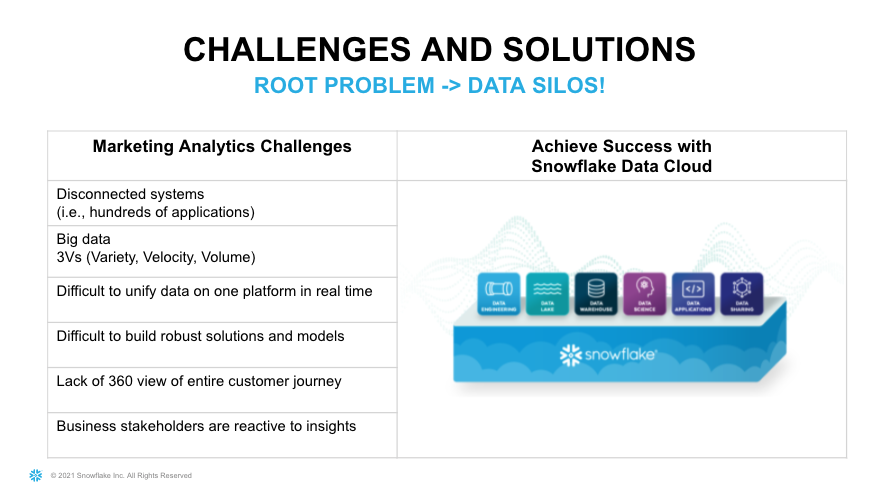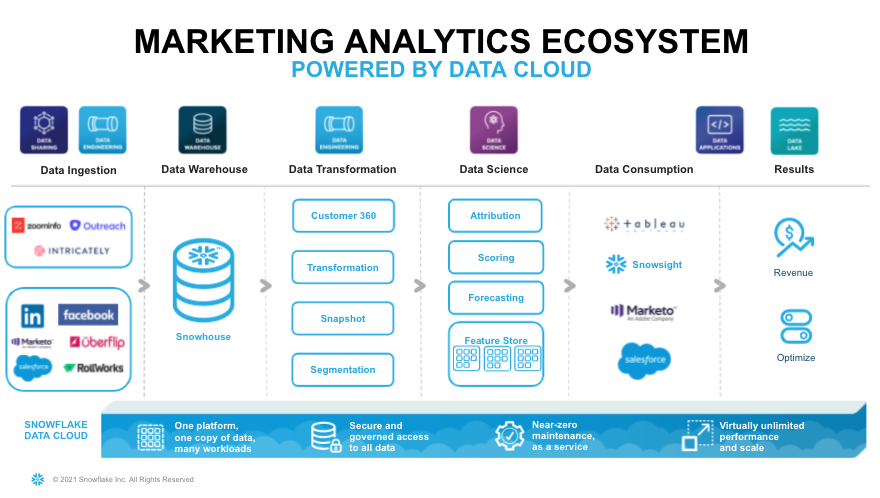Over the past two decades, marketers have faced an uphill battle in trying to turn marketing into a fully data-driven discipline. Our challenge is not that we don’t have enough data but that data has been difficult to access and use. Marketing, sales, and product data is scattered across different systems, and we can’t get a complete picture of what is going on in our businesses.
A team that has been helping us push the ball up the hill is the IT team. CIOs and Chief Data Officers have been trying to solve the fragmented data problem as well. Digital transformation was supposed to be the magic bullet, but our data has been trapped in silos. As marketers, we have launched many programs to solve this problem and we’ve hired consultants to help unlock our data and make it accessible for us. But we all know how that went. IT teams have faced the same hurdle: The technology of the time was not capable of integrating all of this data.
Marketing Analytics Challenges
Marketing analytics professionals face a few major challenges. Because marketers are familiar with the MarTech ecosystem, companies often have dozens or even hundreds of marketing applications, which are commonly disconnected. It’s common for companies to migrate applications from one to another, but it’s very difficult to bring the historical data along with the migration. No company wants to lose valuable data due to an application migration. As those applications grow, the data also grows. Companies often run into the “big data problem.” It’s difficult to unify data on one platform in real time and build robust solutions and models without unified data. In the marketing analytics world, it’s very difficult to fully connect the marketing automation platforms with the sales engagement platforms. Thus, many companies can’t build a 360-degree view to map the entire customer journey, and business stakeholders are reactive to insights.
Our Solution
Despite the challenges, marketing analytics has become more important than ever. This is a trend that does not just impact large corporations; companies of all sizes and industries need to be developing their marketing analytics capabilities to remain competitive and deliver business results. Marketing needs to be data-driven to deliver business results.
At Snowflake, one of the key marketing objectives is to become the industry’s most insights-driven marketing team. We have developed two key metrics—predictive pipeline generation and growth efficiency—to measure the results. To support Snowflake’s bold marketing objective, the marketing intelligence team’s vision is to predict real-time ROI to dynamically optimize all marketing programs, and our ultimate goal is to disrupt the aged B2B marketing analytics practices. Our mission is to build scalable solutions and models to drive efficient growth and proactive actions. At Snowflake, we have been using the Snowflake Data Cloud to solve marketing analytics challenges and deliver outperformed business outcomes.

Our Journey to Data-Driven Marketing
In the early days at Snowflake, our marketing analytics function was similar to that of many companies in that we focused on building dashboards and reports to answer questions such as “What happened, and why did it happen?” I joined Snowflake last year as the Director of Marketing Intelligence to build cutting-edge solutions for marketing with Snowflake’s Data Cloud. In less than six months, we have built more-scalable solutions and data science models to answer questions such as “What will happen, and how can we make it happen?”
There are three key steps that we want to share:
- Establishing close relationships with IT and business stakeholders to align objectives and priorities, which is key to ensuring success
- Developing a clear roadmap to drive the execution and communicate regularly
- Leveraging Snowflake’s Data Cloud to disrupt the data silos across systems and integrate data on one unified data platform
Our Marketing Analytics Ecosystem
Our Snowflake marketing analytics ecosystem is powered by the Data Cloud. We have ingested raw data into Snowflake via Snowflake Secure Data Sharing and data engineering workloads from over 100 data providers, including ZoomInfo, Outreach, LinkedIn, Facebook, Marketo, Salesforce.
Data transformation is the backbone of our analytics ecosystem, in which we are able to orchestrate raw data into more digestible tables in an efficient way, including customer 360, snapshot tables, dimensional tables, and fact tables. At Snowflake, we also use cutting-edge data science models to build marketing attribution and scoring as well as a feature store. After the heavy lifting, we send the critical data to our business applications, such as Tableau, Snowsight, Marketo, and Salesforce to deliver actionable insights to business stakeholders so they can optimize campaigns and drive revenue growth.

Our Realized Business Outcomes
We can summarize business outcomes in three categories: growth, cost, and risk.
- From the growth perspective, with the Snowflake Data Cloud, we have empowered almost everyone with data, so our go-to-market teams are able to leverage insights to increase conversion rates throughout the funnel and significantly increase efficiency.
- From the cost perspective, we are able to intelligently deploy the budget to the right area at the right time. We are also able to increase employee productivity and reduce resource constraints because we have built highly scalable solutions that empower self-service.
- From the risk perspective, with the Snowflake Data Cloud, we are able to meet GDPR and CCPA compliance requirements because the data is managed on the cloud with the best-in-class data protection technology and role-based access control.
To learn more, watch our webinar, Snowflake on Snowflake: Unlocking The Power of Marketing Analytics, now available on demand here.
